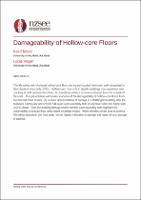| dc.contributor.author | Elwood, Ken | |
| dc.contributor.author | Hogan, Lucas | |
| dc.date.accessioned | 2021-06-22T04:01:48Z | |
| dc.date.available | 2021-06-22T04:01:48Z | |
| dc.date.issued | 2021-04-14 | |
| dc.identifier.uri | https://repo.nzsee.org.nz/xmlui/handle/nzsee/2332 | |
| dc.description.abstract | The life safety risk of precast hollow-core floors during earthquakes have been well recognised in New Zealand since early 2000s. Hollow-core floor unts in ductile buildings may experience web cracking at drift demands less than 1%, sometimes without obvious indication from the outside of the units. This presentation will review evidence of the damageability of hollow-core floors from two ReCast Floor studies: (1) detailed documentation of damage in a Wellington building after the Kaikoura Earthquake and (2) two full-scale super-assembly tests of a typical 1980s RC frame with 200HC floors. Both the building damage review and the super-assembly tests highlight the vulnerability of precast floor units seated on plastic hinges. While retrofits can be used to achieve life safety objectives, the floor units remain highly vulnerable to damage and repair of such damage is dubious. | |
| dc.language.iso | en | |
| dc.publisher | New Zealand Society for Earthquake Engineering | |
| dc.relation.ispartofseries | 2021;1010 | |
| dc.subject | Lessons for design going forward | |
| dc.title | Damageability of Hollow-core Floors | |
| dc.type | Article | |

